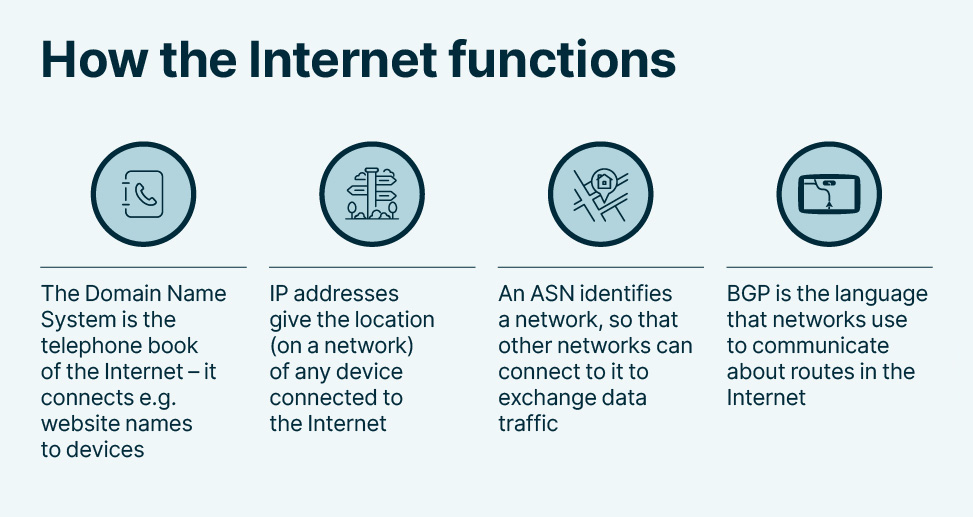Being at the “heart” of the Internet, we often get the question about how the Internet works (Hi Mum!). So here is a shortish and simple answer to this question.
Network of networks
The Googles, Facebooks, and telecom companies of the world each operate their own computer networks – much like we do at home, with our router and WiFi network, but obviously a much bigger version. There are around 65,000 different networks in the world, and they provide different things, for example:
- Internet service providers (ISPs) and telecom companies that provide fixed-line connections to households and companies, as well as mobile operators
- Content networks, such as social media, video and music streaming and gaming networks
- Cloud networks, including application providers offering software as a service (e.g. Microsoft 365)
- e-Commerce platforms and website hosters
- Long-distance carriers that transport data across and between countries and connect continents, including terrestrial, undersea and satellite networks
These networks are interconnected. That is the “inter” part of the word “Internet”. So, to put it simply, the Internet really is a network of networks which are all connected with each other.
Identifiers and navigation system
When you use your smartphone, for example, how does the information get to your phone and apps? Your phone might be connected to your home WiFi provided by your ISP network (like Vodafone, for example), which then talks to the other networks, in order to navigate the data flow to the right destination. The result is that your smartphone can talk to the website, app, cloud resource, or whatever kind of data or device you want to access and interact with.
To navigate any complex system, there need to be ways of identifying things. For example, if we want to call a particular person, we need to know their phone number.
The Internet also has such identifiers, like website names – for example amazon.com – also known as domain names. The Domain Name System (DNS) functions like the telephone directory of the Internet and the networks exchange information from directories which map domain names to what we call IP addresses.
IP addresses are long strings of numbers that identify devices connected to the Internet – like your smartphone – and describe their position within a network, so that they can be found. The IP address provides a lot of information about how to find the resource you are looking for, similar to a street address, but to find the way there we still need a navigation system.
ASN and BGP – what?
Now back to the networks: They are also identified by a unique number, this time called an Autonomous System Number (ASN). An ASN is a little bit like the geographical coordinates for a specific location on a map. It is only because of the ASNs that networks can find and (inter)connect with each other, and data can flow.
The ASN is used as a main factor for what is known as the Border Gateway Protocol (BGP). BGP is a navigation tool for finding networks on the Internet, and it enables computers to talk to each other about how to get to a certain destination, like the amazon.com website. They do this by offering directions to the next network that the data will need to pass through on its way to its destination. This system is not centralized – there is no global map which tells you the best way to get to your destination. Instead, each network passes the data through it – according to a set of policies – and on to neighboring networks, so that the data can continue its journey and reach its destination.
A very, very short summary
So, in summary: We have identifiers for networks, and for devices connected to networks. This information is exchanged between networks using BGP, so that data can get to where it is meant to go.
And obviously this all happens in matter of milliseconds. (And if it doesn’t, that’s a whole other story called latency.)
